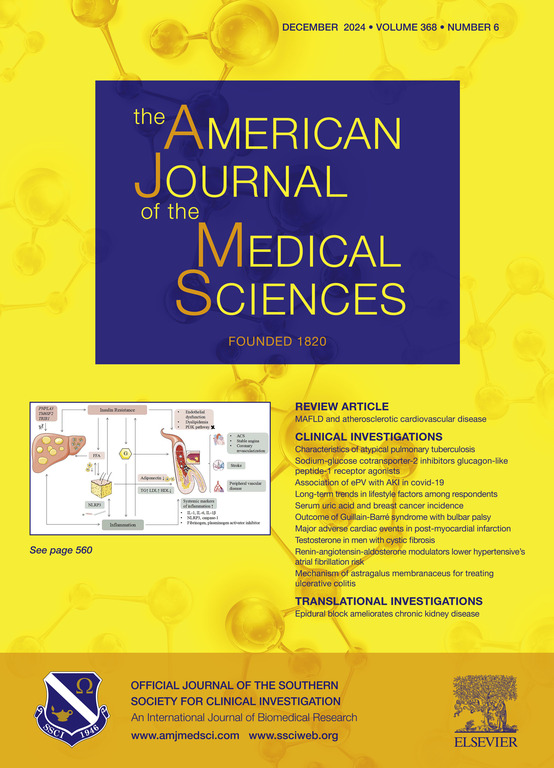Optimizing treatment outcomes in acute-on-chronic liver failure: The role of T2 candida panel in detecting invasive candidiasis
IF 2.3
4区 医学
Q2 MEDICINE, GENERAL & INTERNAL
引用次数: 0
Abstract
Introduction
Acute-on-Chronic Liver Failure(ACLF) is a syndrome characterized by organ dysfunction and high mortality in cirrhotic patients. ACLF has multiple triggers but those precipitated by fungal infection have higher mortality. Early detection and treatment of candidemia have shown mortality benefits in ACLF. The sensitivity of blood cultures ranged from 21 % - 71 %. Given the increase in mortality, it is vital to have a quick yet reliable diagnostic test for the detection of candida. This study examines the risk of developing ACLF and its impact on survival in hospitalized cirrhotic patients with invasive fungal infection via a positive T2 Candida Panel. We also examine the effects of earlier treatment on mortality in those with a positive T2 Candida Panel.
Methods
We performed a retrospective study and included cirrhotic patients admitted from 2017 to 2021. Data collected includes baseline characteristics, labs, progression to ACLF, and mortality outcomes. The stages of ACLF were determined through the use of the CLIF-Consortium ACLF score.
Results
Of the 489 patients sampled, 95 patients developed ACLF during the time of the T2 panel collection, of which 60 (63.2 %) (p ≤ 0.001) patients had a positive T2 Candida Panel. The data also demonstrates that patients who had earlier antifungal initiation had a decrease in mortality (6.15 ± 5.23 versus 13.53 ± 11.42)(p ≤ 001).
Conclusion
Our study shows that a positive T2 Panel leads to more frequent progression of ACLF and worsening survival outcomes. This study shows that earlier treatment of candidiasis via the T2 Panel leads to mortality benefits.
优化急性慢性肝衰竭患者的治疗效果:T2candida panel 在检测侵袭性念珠菌病中的作用。
简介急性慢性肝衰竭(ACLF)是一种以器官功能障碍和肝硬化患者高死亡率为特征的综合征。急性慢性肝衰竭有多种诱因,但由真菌感染引发的急性慢性肝衰竭死亡率较高。早期发现和治疗念珠菌血症可降低 ACLF 患者的死亡率。血液培养的灵敏度从 21% 到 71% 不等。鉴于死亡率的升高,拥有快速而可靠的念珠菌诊断测试至关重要。本研究探讨了通过 T2Candida 阳性样本检测侵袭性真菌感染的住院肝硬化患者罹患 ACLF 的风险及其对生存的影响。我们还研究了早期治疗对 T2Candida 阳性患者死亡率的影响:我们进行了一项回顾性研究,纳入了 2017-2021 年期间收治的肝硬化患者。收集的数据包括基线特征、实验室检查、进展为 ACLF 的情况以及死亡率结果。ACLF的分期通过使用CLIF-Consortium ACLF评分来确定:结果:在抽样的 489 名患者中,有 95 名患者在采集 T2 面板期间发展为 ACLF,其中 60 名(63.2%)(P≤0.001)患者的 T2Candida 面板呈阳性。数据还显示,较早开始使用抗真菌药物的患者死亡率有所下降(6.15 ± 5.23 对 13.53 ± 11.42)(p≤001):我们的研究表明,T2面板阳性会导致前交叉韧带纤维化更频繁地发展,并恶化生存结果。本研究表明,通过 T2 面板对念珠菌病进行早期治疗可降低死亡率。
本文章由计算机程序翻译,如有差异,请以英文原文为准。
求助全文
约1分钟内获得全文
求助全文
来源期刊
CiteScore
4.40
自引率
0.00%
发文量
303
审稿时长
1.5 months
期刊介绍:
The American Journal of The Medical Sciences (AJMS), founded in 1820, is the 2nd oldest medical journal in the United States. The AJMS is the official journal of the Southern Society for Clinical Investigation (SSCI). The SSCI is dedicated to the advancement of medical research and the exchange of knowledge, information and ideas. Its members are committed to mentoring future generations of medical investigators and promoting careers in academic medicine. The AJMS publishes, on a monthly basis, peer-reviewed articles in the field of internal medicine and its subspecialties, which include:
Original clinical and basic science investigations
Review articles
Online Images in the Medical Sciences
Special Features Include:
Patient-Centered Focused Reviews
History of Medicine
The Science of Medical Education.

 求助内容:
求助内容: 应助结果提醒方式:
应助结果提醒方式:


